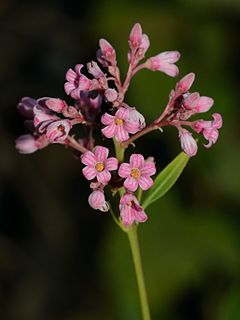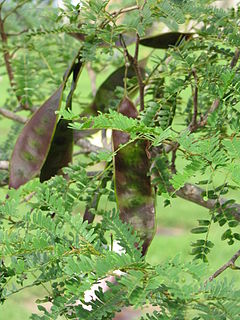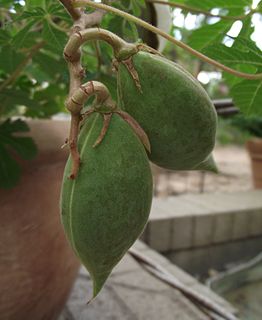
Convolvulaceae, known commonly as the bindweed or morning glory family, is a family of about 60 genera and more than 1,650 species of mostly herbaceous vines, but also trees, shrubs and herbs, and also including the sweet potato and a few other food tubers.

Anacardium, the cashews, are a genus of flowering plants in the family Anacardiaceae, native to tropical regions of the Americas.

Larrea is a genus of flowering plants in the caltrop family, Zygophyllaceae. It contains five species of evergreen shrubs that are native to the Americas. The generic name honours Bishop Juan Antonio Hernández Pérez de Larrea, a patron of science. South American members of this genus are known as jarillas and can produce fertile interspecific hybrids. One of the more notable species is the creosote bush of the southwestern United States and northwestern Mexico. The King Clone ring in the Mojave Desert is a creosote bush clonal colony estimated to be about 11,700 years old.

Zygophyllaceae is a family of flowering plants that contains the bean-caper and caltrop. The family includes around 285 species in 22 genera.

Ptelea is a genus of flowering plants in the citrus family, Rutaceae. The name, of Greek derivation, is the classical name of the elm tree. Carl Linnaeus used that word for this genus because of the resemblance of its fruit to that of the elm. Members of the genus are commonly known as hoptrees.

Theobroma is a genus of flowering plants in the mallow family, Malvaceae, that is sometimes classified as a member of Sterculiaceae. It contains roughly 20 species of small understory trees native to the tropical forests of Central and South America. The generic name is derived from the Greek words θεός (theos), meaning "god," and βρῶμα (broma), meaning "food". It translates to "food of the gods."

Parkinsonia, also Cercidium, is a genus of flowering plants in the pea family, Fabaceae. It contains about 12 species that are native to semi-desert regions of Africa and the Americas. The name of the genus honors English apothecary and botanist John Parkinson (1567–1650).

Sapindus is a genus of about five to twelve species of shrubs and small trees in the lychee family, Sapindaceae, native to warm temperate to tropical regions of the world. The genus includes both deciduous and evergreen species. Members of the genus are commonly known as soapberries or soapnuts because the fruit pulp is used to make soap. The generic name is derived from the Latin words sapo, meaning "soap", and indicus, meaning "of India".

Sicyos is a flowering plant genus of the family Cucurbitaceae. Members of the genus are commonly known as burr cucumbers.

Brahea is a genus of palms in the family Arecaceae. They are commonly referred to as hesper palms and are endemic to Mexico and Central America. All Hesper Palms have large, fan-shaped leaves. The generic name honours Danish astronomer Tycho Brahe (1546-1601).

Apocynoideae is a subfamily of the flowering plant family Apocynaceae. It contains about 78 genera with roughly 860 species. Several genera are of pharmacological interest - notably those - such as Strophanthus - which have furnished highly effective arrow poisons, due to their cardiac glycoside content. The subfamily includes many species with flowers of considerable ornamental value, the best-known of which is Nerium oleander, the familiar Oleander. It also contains the remarkable pachycaul genera Adenium and Pachypodium.

Forestiera is a genus of flowering plants in the olive family, Oleaceae. Members of the genus are often called swampprivets. Most are shrubs.
Neoluederitzia is a genus of flowering plants in the caltrop family, Zygophyllaceae. The sole species is Neoluederitzia sericocarpa. It is endemic to Namibia. Its natural habitat is intermittent freshwater marshes. It is unusual within the family for being dioecious: having male and female flowers on separate plants.

Porlieria is a genus of flowering plants in the caltrop family, Zygophyllaceae. Species within this genus are shrubs or small trees of dry subtropical regions. The generic name honours Spanish ambassador Don Antonio Porlier de Baxamar.

Lysiloma is a genus of flowering plants in the legume family, Fabaceae.

Tribuloideae is a subfamily of the flowering plant family Zygophyllaceae.
Oenothera pubescens, known commonly as the South American evening-primrose, is a plant in the evening primrose family native to the Southwestern U.S. ; Mexico ; Guatemala; and Western South America. It is used locally in folk medicine.

Balanites is an Afrotropical, Palearctic and Indomalayan genus of flowering plants in the caltrop family, Zygophyllaceae. The name Balanites derives from the Greek word for an acorn and refers to the fruit, it was coined by Alire Delile in 1813.

Abronia, the sand-verbenas or wild lantanas, is a genus of about 20 species of annual or perennial herbaceous plants in the family Nyctaginaceae. Despite the common names, they are not related to Verbena (vervains) or lantanas in the family Verbenaceae. They are closely allied with Tripterocalyx.

Amoreuxia is a genus of flowering plants in the achiote family, Bixaceae. It was formerly placed in the family Cochlospermaceae. Members of the genus are commonly known as yellowshow. They are native to Mexico, Central America, Colombia, Peru, Curaçao, and the southwestern United States.
- Amoreuxia gonzaleziiSprague & L.Riley – Santa Rita Mountain yellowshow - Sonora, Sinaloa, Jalisco, southern Arizona
- Amoreuxia malvifoliaA.Gray - Chihuahua, Durango
- Amoreuxia palmatifidaMoc. & Sessé ex DC. – Mexican yellowshow - Mexico, Central America, Colombia, Arizona, New Mexico
- Amoreuxia wrightiiA.Gray – Wright's yellowshow - Curaçao, Peru, Chihuahua, Durango, Coahuila, Nuevo León, San Luis Potosí, Tamaulipas, Campeche, Yucatán, Quintana Roo, Campeche, Texas



















